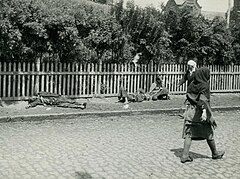Holodomor - Simple English Wikipedia, the free encyclopedia
| Holodomor Голодомор | |
|---|---|
 Starved peasants on a street in Kharkiv, 1933 | |
| Country | Soviet Union |
| Location | Central and eastern Ukraine |
| Period | 1932–1933 |
| Total deaths | 7.5 million - 13 million. |
| Observations | |
| Relief | Foreign relief rejected by the State. Respectively 176,200 and 325,000 tons of grains provided by the State as food and seed aids between February and July 1933.[1] |
The Holodomor (Ukrainian: Голодомор, which means "murder by hunger") was a man-made famine that happened in Ukraine in 1932 and in 1933. It is also known as the Terror-Famine or Great Famine. At that time, Ukraine was a part of the Soviet Union. About seven million people starved to death in the Holodomor.[2]
Joseph Stalin was the leader and dictator of the Soviet Union, which was a communist country. He made farmers in the Soviet Union change the way they farmed, then he tried to make the farmers work harder for the government-owned farms, for less money.[3] Many people in Ukraine did not want to go along with this. When Ukraine had a famine, Stalin refused to help the people in Ukraine. Instead, the government took food away from people. It became illegal (against the law) to pick up food from the ground of fields.[4] The government also tried to stop people from moving around the country to look for food.
Scholars and politicians using the word Holodomor say the man-made aspects of the famine, was a genocide; some consider the huge loss of life comparable to the Holocaust.[5] They argue that the Soviet policies were an attack on the rise of Ukrainian nationalism and therefore is a genocide.[6][7][8][9][10]

Other scholars say that the Holodomor was an unexpected consequence of the rapid and massive industrialization started by Stalin, that brought radical economic changes to the farmers and the country, and which was not done on purpose.[8][11][12]
Images of Holodomor victims[change | change source]
- Passers-by ignore corpses of starved peasants on a street in Kharkiv, Ukraine, 1933
- Children are digging up frozen potatoes in the field of a collective farm in Udachne village, Donetsk Oblast, Ukraine, 1933
Images of Holodomor memorials[change | change source]
- "Light the candle" event at a Holodomor memorial in Kyiv, Ukraine
- Memorial at the Andrushivka village cemetery, Vinnytsia Oblast, Ukraine
- Memorial in Poltava Oblast, Ukraine
- Poster by Ukrainian-Australian artist Leonid Denysenko
- Stamp of Ukraine of the year 1993.
- Viktor Yanukovych and Dmitry Medvedev at the Memorial to the Holodomor Victims in Kyiv, Ukraine
| List of countries which officially recognize the Holodomor as genocide | ||
|---|---|---|
|
| ||
Other websites[change | change source]
- Ukrainian Genocide Famine Foundation USA Archived 2011-10-28 at the Wayback Machine
- Famine Genocide Commemorative Committee Ukrainian Canadian Congress Archived 2012-08-31 at the Wayback Machine
- Findings of the Commission on the Ukraine Famine Archived 2011-06-04 at the Wayback Machine, U.S. Commission on the Ukraine Famine, Report to Congress. Adopted by the Commission, 19 April 1988
- Joint declaration at the United Nations in connection with 70th anniversary of the Great Famine in Ukraine 1932–1933
- Address of the Verkhovna Rada to the Ukrainian nation on commemorating the victims of Holodomor 1932–1933
References[change | change source]
- ↑ Davies & Wheatcroft 2010, pp. 479–484.
- ↑ "Famine - Genocide in Ukraine 1932 - 1933". faminegenocide.com. Archived from the original on March 31, 2007. Retrieved April 2, 2010.
- ↑ Young, Cathy (December 8, 2008). "Remember the Holodomor". The Weekly Standard. Archived from the original on January 5, 2012. Retrieved April 2, 2010.
- ↑ "Thanks to US for Holdomor Memorial". Cyber Cossack. Archived from the original on January 17, 2011. Retrieved April 2, 2010.
- ↑ Zisels, Josef; Kharaz, Halyna (11 November 2007). "Will Holodomor receive the same status as the Holocaust?". "Maidan" Alliance. Archived from the original on 28 June 2007. Retrieved 21 July 2012.
- ↑ Finn, Peter (27 April 2008). "Aftermath of a Soviet Famine". The Washington Post. Retrieved 21 July 2012.
There are no exact figures on how many died. Modern historians place the number between 2.5 million and 3.5 million. Yushchenko and others have said at least 10 million were killed.
- ↑ Marples, David (30 November 2005). "The Great Famine Debate Goes On..." Edmonton Journal. Archived from the original on 15 April 2009. Retrieved 21 July 2012.
- ↑ 8.0 8.1 Kulchytsky, Stanislav (6 March 2007). "Holodomor of 1932-33 as genocide: gaps in the evidential basis". Den. Retrieved 22 July 2012. Part 1 Archived 2007-10-20 at the Wayback Machine - Part 2 Archived 2009-10-15 at the Wayback Machine - Part 3 Archived 2012-10-25 at the Wayback Machine - Part 4 Archived 2012-10-25 at the Wayback Machine
- ↑ Bilinsky 1999.
- ↑ Kulchytsky, Stanislav. "Holodomor-33: Why and how?". Zerkalo Nedeli (25 November – 1 December 2006). Retrieved 21 July 2012. Russian version Archived 2007-07-16 at Archive.today; Ukrainian version[permanent dead link].
- ↑ Wheatcroft 2001b, p. 885.
- ↑ 'Stalinism' was a collective responsibility. Kremlin papers, The News in Brief, University of Melbourne, 19 June 1998, Vol 7 No 22


 French
French Deutsch
Deutsch









